Company reputation has always been an essential part of doing business. While word of mouth used to be the primary way to determine a company’s reputation, nowadays, it’s all about online reviews. Your online reviews, whether positive or negative, impact your business. This article will explore positive reviews examples and show you how to use customer feedback as marketing gold.
Why online reviews matter
The stats are in. Across the board, they show that potential customers care about online reviews. A lot.
Recent studies show that 93% of consumers read reviews before buying. The same report shows that ratings and reviews significantly impact a buying decision—even more so than price and free shipping.
Personal recommendations are still important. However, a 2024 consumer review survey by BrightLocal revealed that 50% of consumers trust online reviews as much as a recommendation from a friend or loved one.
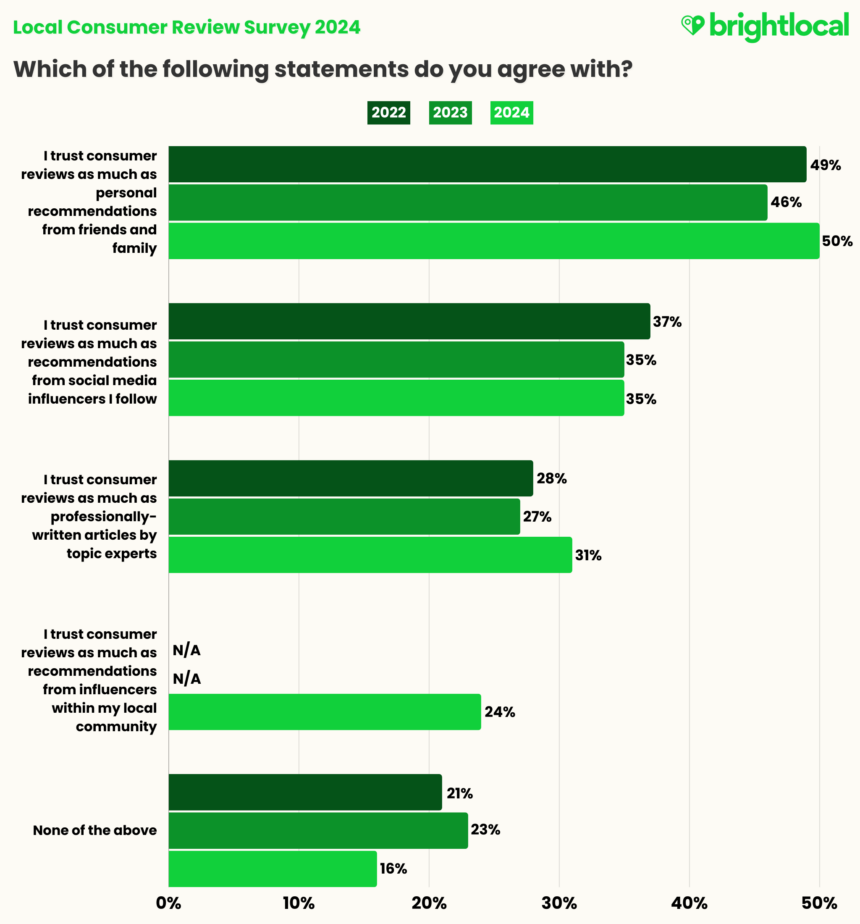
With numbers like this, it’s easy to see why every business owner needs to pay attention to online reviews.
How to Encourage Positive Reviews
1. Provide exceptional service
Delivering outstanding service is the foundation for positive reviews. Ensure your clients have a seamless and satisfying experience.
2. Ask for reviews
Encourage your clients to leave reviews by asking at the right moment—typically after a successful project or positive interaction.
Simplify the review process by providing direct links and clear instructions. The easier it is for clients to leave feedback, the more likely they will do so.
4. Incentivize reviews
Offer incentives like discounts, free consultations, or entry into a giveaway in exchange for reviews. Ensure these incentives comply with platform policies.
5. Respond to reviews
Engage with your reviewers by thanking them for positive feedback and addressing any concerns raised. This interaction demonstrates that you value their opinions.
Seven positive reviews examples to use in your marketing
Your online reviews don’t have to be static. They are a pool of authentic feedback from customers you can repurpose. Below are seven positive review examples of transforming your customer feedback into a valuable asset.
A social media wall is a feed pulled from all your channels and displayed in one place. You can build your “social wall of fame” by curating your five-star reviews and testimonials from your social feeds.
You can use your social wall for events, websites, campaigns, displays, and other avenues to help generate positive responses from reviews.
With tools like Walls.io, you can use your social wall for lead generation and a tool for building brand trust and loyalty. Social walls can also benefit internal communications and specific hashtag campaigns. It is worth exploring if you are seeking solutions for these areas.
Here’s a social wall with positive reviews examples by Walls.io.
Create your positive reviews widget for free
Have a positive reviews page on your website
Instead of having potential customers dig to find online reviews for your business, make it easy for them by hosting a positive reviews page on your website.
Beaches of Normandy Tours, a destination tour company, is an example of utilizing positive customer reviews.
On their website, they have an entire page dedicated to online reviews. The page includes a score breakdown of noteworthy categories, including customer service, sites, guides, and transportation. Prospective customers can see past customers have had a great experience with this company.
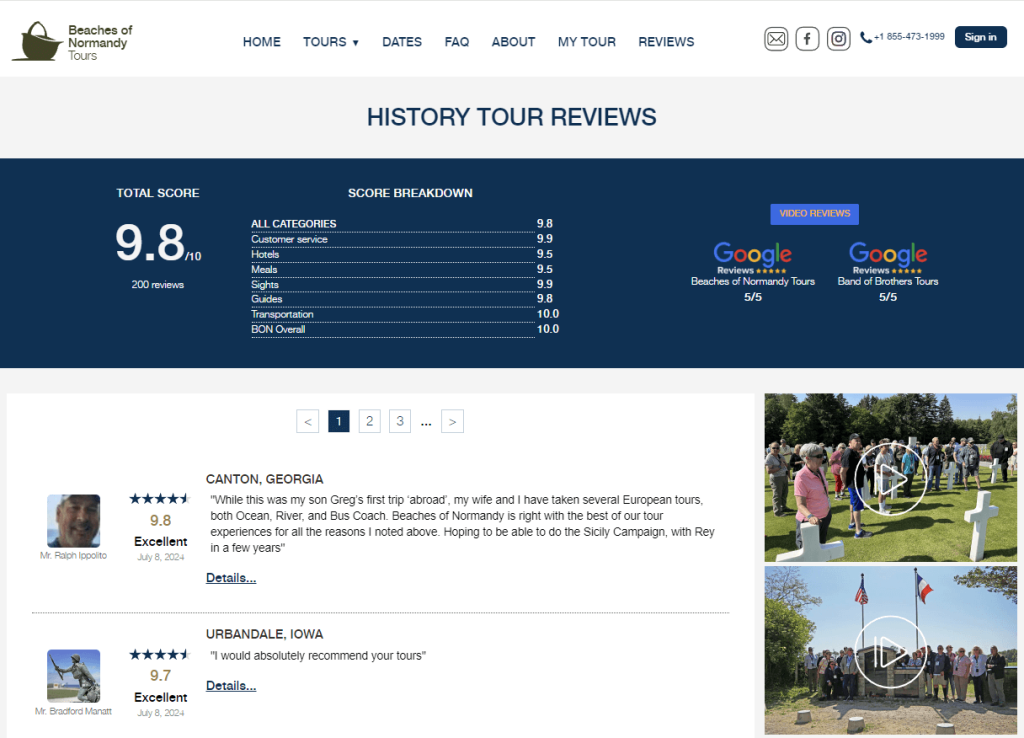
Additionally, Beaches of Normandy Tours has authentic user-generated video reviews. This approach allows customers to leave positive feedback in their own words while also building social media channel growth by hosting the videos on YouTube.
This is great content distribution. With one review, they can boost traffic to their website, increase conversions, and grow a social media channel.
Speaking of posting on social media channels, customer reviews make excellent content.
Form Health, a nutrition program offering weight loss medication, is an excellent example of using their customer reviews on social. They share personal experiences and user testimonials on their Instagram account, increasing their reach.

Like Beaches of Normandy Tours, Form Health uses its web pages well and hosts online reviews showcasing customer satisfaction with written and video user feedback. They also add third-party reviews to their website for additional social proof.
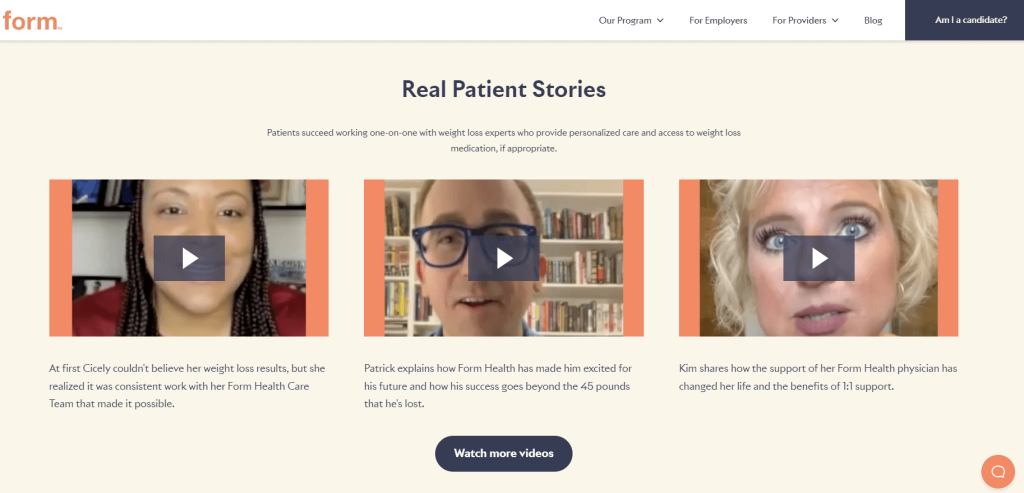
Collct positive reviews from social media and display them on your website
Respond to negative feedback
Despite your best efforts, you’re never going to please everybody. In fact, 96% of potential customers intentionally seek out negative reviews when researching a buy.
Negative reviews can be powerful tools if used properly. Users will seek out bad reviews because they know there’s no such thing as perfection, and they want to be aware of the negatives upfront.
This is why it’s essential to respond to your bad reviews. Even if you think they’re unfair or untrue.
How you respond to negative feedback tells a potential customer a great deal:
- It demonstrates that you are in touch with your clientele
- It shows your customer service in action
- It shows how you rectify mistakes
- It displays your professionalism
- It provides valuable feedback
It’s tempting to ignore your bad reviews or reply snarkily, but keep it professional. As the statistics indicate, 99.9% of potential customers will be reading your reviews. Above all, you want to show your commitment to customer satisfaction and professionalism.
When you do, you contribute to your brand’s positive reputation and earn customers’ respect and trust.
Use case studies
Case studies show your product in action. They demonstrate real users solving real problems with your product. Case studies can be written or visual. Ideally, you can build one case study and do both.
Take, for example, the lead scoring software company Breadcrumbs.
On their Case Study page, they have an embedded video showing how a customer used their high-quality products to solve the problem of misalignment between their sales and marketing departments.
From there, they also built two text-based studies showing the improvement in quantifiable statistics.
(Image source)
This approach gives the best of both worlds. Prospective customers can hear about the wonderful experience your customers had with the product and read the specifics and technicalities themselves.
Have a Google Business Profile
Unsurprisingly, Google remains number one on the list of top review sites.
Nearly everyone will Google the product they want to buy or the company they are considering working with. When they do, a five-star rating scale and a list of reviews will appear.
If you don’t have a Google Business Profile, you’ll lose trust and credibility by:
- Creating confusion about whether you are still in business
- Creating a frustrating customer experience
- Having no social proof from online reviews
- Limiting the possibility of conversions
- Displaying inaccurate information
It’s straightforward and easy to overlook, but it’s worth the time to set up and keep updated.
Do not generate fake reviews
If your business hasn’t generated many reviews yet, it may be tempting to create fake ones to garner interest.
This is a bad idea for many reasons.
As AI-powered tools have become more prevalent in content spaces, the average consumer has become more aware of fake content.
If prospective customers perceive your reviews as fake, you’ll damage your online reputation more than having few (or zero) authentic user-generated reviews.
The data has shown things that can raise suspicions that your online reviews aren’t genuine, including:
- No negative reviews — glowing 5-star reviews across the board raise suspicions that your review responses aren’t real. Everyone knows there are some drawbacks to everything, so having some bad mixed with the good boosts trust for many consumers.
- Overlap in review content — Many reviews that say the same (or similar) things raise a red flag. This is often an indicator that a review has been generated with AI.
- Anonymous or no text – reviews left by users who have no name or reviews that just leave a star rating and no text may be considered fake.
Overly positive or overly negative – reviews overflowing with praise or negativity are perceived as disingenuous.
Do the work of generating real online reviews, and your business will thrive. Try to cut corners, and it’ll have you re-building from ground zero.
Positive reviews examples: the future
The data shows that modern buyers rely on reviews to make buying decisions. Online reviews are referenced and trusted, and there’s no indication that this trend will end soon.
As a business owner, it’s paramount that you pay attention to the potential that online reviews can have for your bottom line.
Ensure your business is set up to receive reviews (such as an updated Google Business Profile). Respond professionally to every review, especially the negative ones. And capture the growth potential of using reviews in your marketing strategy by showcasing them on your website, social media channels, and social walls.
Your customers’ excellent experiences, spoken in their own words, are one of the most powerful tools in your marketing arsenal. Spin words into gold by using them to their full potential.
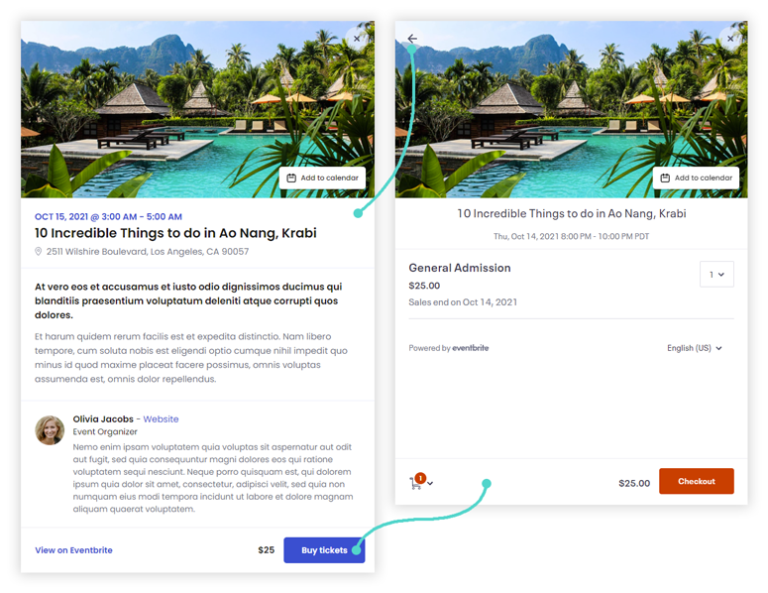
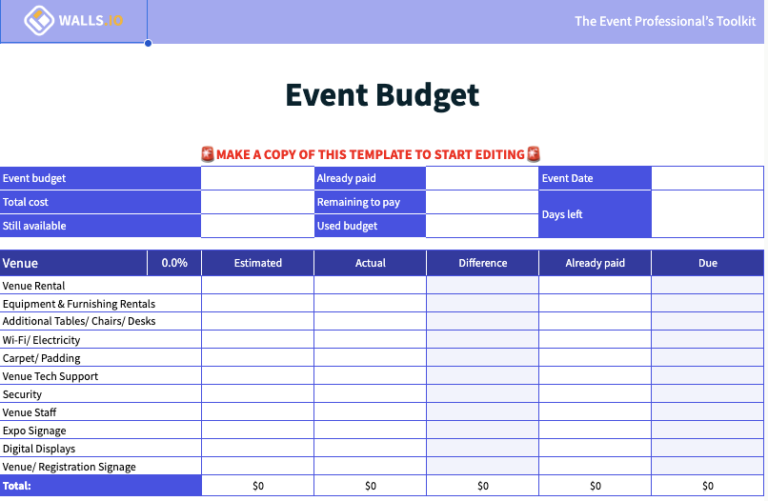


![How to Add Instagram Feed to Shopify Website [Full Guide]](https://cssamsu.org/wp-content/uploads/2024/08/how-to-add-instagram-feed-to-shopify-website-full-guide-768x398.png)
